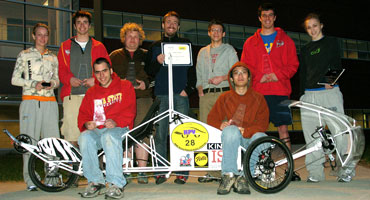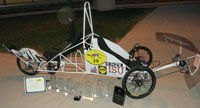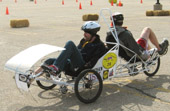Iowa State's lighter, better human powered vehicle wins engineering competition
05-07-08

Members of Iowa State University's Human Powered Vehicle Team show off their vehicle and the awards they brought back from the recent Human Powered Vehicle Challenge East in Madison, Wis. From left to right are Leah Smith, Kris Anderson, Jeff Feuerhelm, Aaron Lind, Zach Reinhart, Greg Swiss, Lei Huang, Jake Connor and Katie Lonergan. Not pictured are team members Brad Thomas and Nate Kaiser. Photo contributed by Jeff Feuerhelm.
Contacts:
Jeff Feuerhelm, Human Powered Vehicle Team, (507) 272-7227, jeff34@iastate.edu
Zach Reinhart, Human Powered Vehicle Team, (319) 431-9657, zrein@iastate.edu
Mike Krapfl, News Service, (515) 294-4917, mkrapfl@iastate.edu
Iowa State's lighter, better human powered vehicle wins engineering competition
AMES, Iowa -- They couldn't help the engineers' talk of exoskeleton design, Ackerman analysis and truss support.
But the members of Iowa State University's Human Powered Vehicle Team were quick to explain what they meant. And they were happy to explain why the vehicle they designed and built won the multi-rider class at the Human Powered Vehicle Challenge East at the University of Wisconsin-Madison April 25-27. The annual competition is sponsored by ASME, founded in 1880 as the American Society of Mechanical Engineers.
First, said Jeff Feuerhelm, a junior from St. Charles, Minn., who's studying mechanical engineering, this year's vehicle is 25 percent lighter than last year's model. The secret to chopping the weight down to 90 pounds was that exoskeleton design.
That means the vehicle's riders are sitting inside a frame of steel tubing, explained Zach Reinhart, a senior in mechanical engineering from Cedar Rapids. Last year's vehicle featured a steel backbone that supported the riders and that required some thicker, heavier tubing. The truss design -- it looks like a reinforced bridge support -- allows for thinner, lighter steel.
Their vehicle, nicknamed "Le Tigre" and featuring some tiger stripes on the rear fender, is a three-wheel design with its two riders sitting back to back. It's a design the team has used before, but again, this year's version is better.
Brad Thomas, a senior from Newton who's studying mechanical engineering, explained this year's 27-speed drivetrain allows the two riders to pedal independently. Last year, both riders had to pedal or coast together. The new version allows one rider to coast through a corner while the other pedals, providing power through the turn and a quicker jump back to speed.
Then Reinhart started talking about the team's Ackerman analysis of the vehicle's front end. That, he explained, allowed the team to design the steering mechanism so the two front wheels have slightly different turning angles. That creates better steering and better speed.

Iowa State's Human Powered Vehicle Team earned nine awards during the recent competition in Madison, Wis. Photo contributed by Jeff Feuerhelm.
Add up all the improvements and the result is nine awards to line up for a picture, including first overall in the multi-rider category, first in design for multi-rider vehicles, second in the utility contest (which simulates the stops, starts, turns and carrying capacity required to run an errand), second in the multi-rider sprint and second in utility design.
The Iowa State student engineers spent two semesters designing and building their vehicle. They also had to raise $4,000 and ask for help with equipment, gear and supplies.
And yes, team members said, they're already thinking about whether they can improve next year's vehicle.
"I'm sure we can," said Aaron Lind, a sophomore from Cedar Rapids majoring in materials science and engineering. "There's always room for improvement. To start, we need to make it even lighter."
-30-
